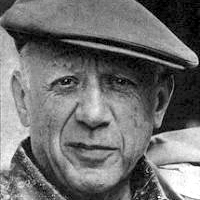 | ||
| 1. Mont Ste-Victoire |
I started early to avoid the heat of mid-afternoon and got to see the morning mist burning off the vineyards and mountains. I stopped often walk up the trails a bit and to take photos. Driving the back roads is the best way to see the countryside but they are very narrow. (Amused that the speed limit was 90kmh and I couldn't drive faster than 45kmh.) There are no shoulders to the road and barely enough room to pass oncoming traffic, so driving is not for the fainthearted here, especially on the switchbacks. I found it nightmarish passing the fanatic cyclists, of which there were many, because I couldn't see far enough around the bends.
Drifts of periwinkle-blue cornflowers line the roads and colour the fields. Scrubby vegetation takes over higher up and small oak trees predominate lower down along with the umbrella pines so common in the south of France.
Mont Ste-Victoire dominates the landscape east of Aix en Provence - rugged, grey granite rocks tower above you with not a tree at the top, just the Cross of Provence on the peak. The road does not go to the top, you have to hike the trails or rock climb to get there. I followed the mountain along its southern flank, and once past the first village, the fields became vineyards as far as I could see.
An hour and a half later, I pulled off the "main road" into Vauvenargues, a small village strung out like washing on a line along a narrow steep valley on the north side of MSV. Its main road is narrow and twisty with the front doors of houses opening right onto the street. Cafes' put their tables along its sides too making driving along it nerve-wracking given the kids and dogs playing. Later in the day parking would be impossible here, but I was early.
I went straight to the chateau and learned, "Yes, it was open but you need a reservation to do the tour." After some sweet talking with the woman at the gate, I was "in." Ten Euros per person, eight if you're a senior, gets you into the chateau for a guided tour and into the exhibition of Picasso's etchings. (They were odd!)
 2. Picasso (Image via Wikipedia)I loved the chateau from the outside. It sits high on a rock surrounded by trees and dates back centuries with towers, ramparts, and a private terrace that Picasso filled with his sculptures. Picasso fell in love with the chateau at first sight in the late 1950's and lived in it from 1959 to 1961 when he was 80+ and still working. He never painted this home but did a few paintings of the village. Sadly, he couldn't stay longer as ill-health demanded he move closer to his doctors on the Cote d'Azur.
2. Picasso (Image via Wikipedia)I loved the chateau from the outside. It sits high on a rock surrounded by trees and dates back centuries with towers, ramparts, and a private terrace that Picasso filled with his sculptures. Picasso fell in love with the chateau at first sight in the late 1950's and lived in it from 1959 to 1961 when he was 80+ and still working. He never painted this home but did a few paintings of the village. Sadly, he couldn't stay longer as ill-health demanded he move closer to his doctors on the Cote d'Azur.Inside, the building is austere and not as big as I expected but, even so, Picasso and his wife must have rattled around in it. The rooms are very plain where the family lived, stark even. Some of the artist's sculptures are dotted about, but no paintings. The ravages of time and water damage are apparent everywhere.
Overall I found it hard to imagine Picasso living here because there was so little left of his spirit. One exception was the bathroom he had installed next to his bedroom. In this huge, rather bleak room bigger than most people's living rooms, Picasso had painted an exuberant mural of a faun playing a flute in a forest on the wall behind the bath. His second wife, Jacqueline, bought garden furniture to fill the emptiness of the room. The only other room that spoke volumes of the man was his studio. Left as it was when Picasso left, there are easels, huge pots of paints on a refectory size table, his brushes, and two chairs on which he painted designs on the upholstery. Even his paint splatters are still visible on the tiled floor.
Picasso was buried right outside the front door in 1972 and his spouse stuck a large bronze nude of his on top of the grave. In 1986 after Jacqueline committed suicide, she was buried beside him. Now the chateau is owned by her daughter (Picasso's step-daughter) who dreamed of establishing a foundation to open the chateau permanently soon afterwards. The locals opposed her idea and that's why the chateau has been inaccessible till last year.
Visitors are not permitted to take any photographs of the exterior or interior once inside the gate, which disappointed me, likewise, the unwillingness to accommodate English-speaking art afficiandos. When I asked for a photocopy of the brief translation of the guide's long talk, I was again told it was not allowed. How many more people would come to pay homage to one of the world's great artists if there was more effort to welcome them along with a website that was up-to-date. I couldn't even find out if the chateau would be open next summer.
 | ||
| 3. Chateau de Vauvenargues. Picasso's grave is here. |
OTHER POSTS ABOUT AIX EN PROVENCE:
STAMP #8
STAMP #7
STAMP #6
STAMP #5
STAMP #4
STAMP #3
STAMP #1

No comments:
Post a Comment